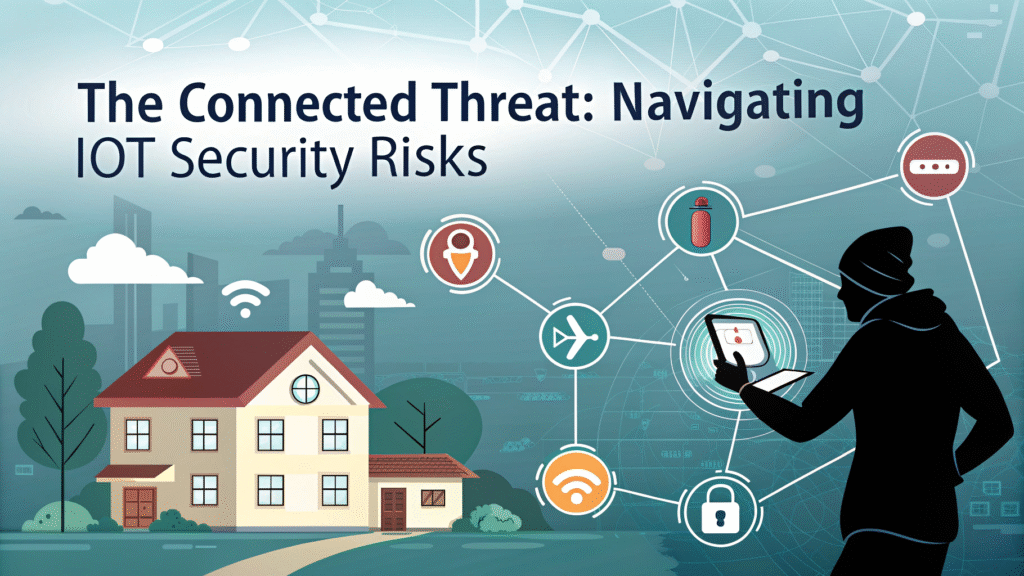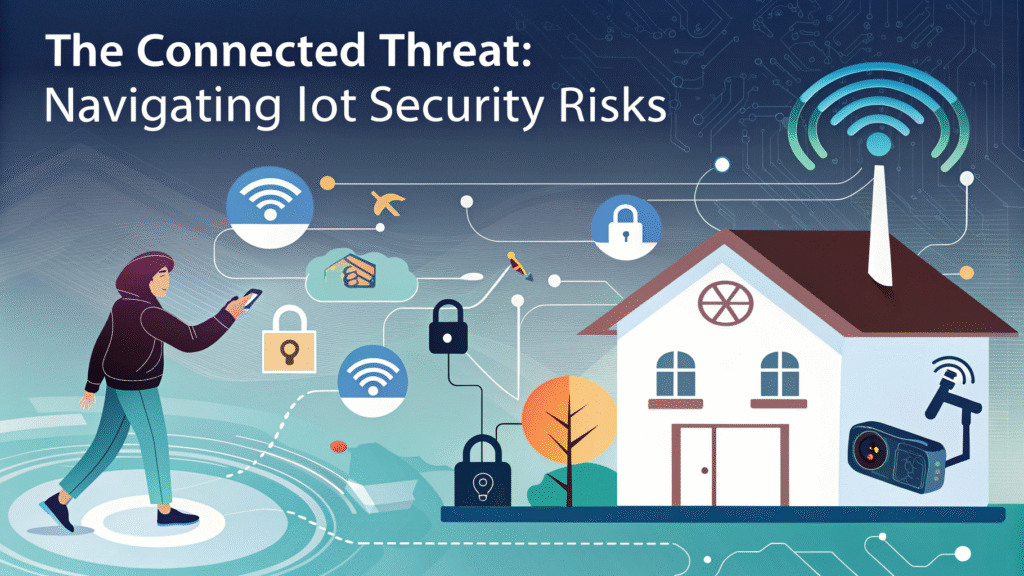
Introduction
From voice-activated assistants and smart thermostats to connected cars and fitness trackers, the Internet of Things (IoT) is becoming a part of our daily lives. This network of physical devices offers unmatched convenience and efficiency. However, this hyper-connectivity comes with a hidden cost: it dramatically expands the attack surface for cybercriminals. Understanding IoT security risks is no longer optional for entrepreneurs, marketers, and tech-savvy individuals. In this guide, “The Connected Threat: Navigating IoT Security Risks,” we highlight vulnerabilities in our smart world and provide a roadmap to stronger security, essential for protecting personal privacy, business assets, and even physical safety.
History & Evolution of IoT Security
The story of IoT security is one of rapid innovation often outpacing safety considerations.
- The Birth of Connectivity (1980s-2000s): The concept of connected devices began with simple machines like a Coca-Cola vending machine monitored over ARPANET. Security was an afterthought, as these were isolated experiments.
- The Proliferation Era (2010s): With the advent of cheap sensors and ubiquitous Wi-Fi, consumer IoT devices exploded. Smartphones became the remote controls for our lives. However, manufacturers often prioritized speed-to-market and low cost over robust security. As a result, many devices were inherently vulnerable.
- The Wake-Up Call (Mid-2010s–Present): Major attacks, such as the Mirai botnet, hijacked thousands of insecure cameras and routers to launch massive cyberattacks. Consequently, these incidents exposed the sheer scale of IoT security risks. As a result, regulators and manufacturers began taking the threat more seriously.
Audience & Demographics: Who Needs to Worry?
Virtually everyone interacting with technology is a stakeholder, but specific groups face unique challenges:
- Homeowners & Renters: Anyone with a smart home device is responsible for their personal network’s security.
- Automotive Owners & Manufacturers: With the rise of connected cars, drivers and automotive companies face increasing risks, from data theft to remote vehicle manipulation.
- Healthcare Patients & Providers: Because wearables and connected medical devices—such as insulin pumps and pacemakers—handle extremely sensitive data, security becomes a life-or-death matter.
- Entrepreneurs & Businesses: Additionally, companies using IoT for operations—such as smart offices or inventory tracking—or selling IoT products must prioritize security to protect customer data and maintain their brand reputation.
Key IoT Security Risks & Functions
The IoT security risks landscape is diverse, but several key vulnerabilities are common across devices:
- Weak Authentication: Default or easy-to-guess passwords (like “admin” or “password”) are a primary entry point for attackers.
- Lack of Encryption: Many devices transmit data over the network in plain text, allowing anyone to intercept and read personal information.
- Insecure Software & Firmware: Devices often ship with outdated software containing known vulnerabilities and lack a mechanism for automatic security updates.
- Data Privacy Concerns: IoT devices collect vast amounts of personal data, but users are often unaware of how it’s stored, used, or shared with third parties.
Business & Marketing Potential of IoT Security
For forward-thinking businesses, addressing IoT security is a significant opportunity.
- A Powerful Marketing Advantage: In a market crowded with similar devices, promoting strong security features can be a key differentiator. Transparency about IoT security risks and how you mitigate them builds immense consumer trust.
- Building Brand Loyalty: Customers are increasingly wary of connected devices. Companies that demonstrably prioritize security from the design phase will foster long-term loyalty.
- Ensuring Regulatory Compliance: As governments introduce stricter IoT security laws (like the UK’s Product Security and Telecommunications Infrastructure Act), proactive compliance avoids fines and facilitates market access.
Best Practices & Tips for Mitigating IoT Security Risks
Protecting yourself and your business requires a proactive approach. Here are actionable steps:
For Individuals & Families
- Change Default Credentials Immediately: This is the single most important step. Set a strong, unique password for every IoT device.
- Segment Your Network: Use a “Guest Network” for your IoT devices. This prevents a compromised smart bulb from accessing your computer or smartphone.
- Keep Firmware Updated: Regularly check for and install firmware updates from the manufacturer to patch known vulnerabilities.
- Disable Features You Don’t Use: If a device has remote access, UPnP, or other features you don’t need, turn them off to reduce the attack surface.
For Businesses & Entrepreneurs
- Adopt a “Security by Design” Philosophy: Integrate security into the product development lifecycle, not as an afterthought.
- Implement Robust Authentication: Require strong passwords and offer multi-factor authentication (MFA) for added security.
- Plan for the Product’s Entire Lifecycle: Have a clear policy for supporting devices with security patches, even after you stop selling them.
- Be Transparent with Customers: Clearly communicate what data you collect, how it’s used, and the steps you take to protect it.
Alt text: A visual representation of common IoT security risks and how to defend against them.
Challenges & Limitations
Despite best efforts, several inherent challenges complicate IoT security:
- The Diversity of Devices: There is no one-size-fits-all security solution for the vast array of IoT devices with different capabilities.
- Resource Constraints: Many IoT devices have limited processing power and memory, making it difficult to run advanced security software.
- Consumer Awareness Gap: Many users prioritize convenience over security, leaving devices with default settings and outdated software.
- The Long Tail of Legacy Devices: Millions of older, unsupported IoT devices are still in use, creating permanent vulnerabilities in the ecosystem.
Future Outlook
The future of IoT security will be shaped by emerging technologies and trends:
- Furthermore, AI-powered security leverages artificial intelligence to detect anomalous behavior in IoT networks, allowing it to identify threats faster than traditional methods.
- Blockchain for Integrity: Blockchain technology could be used to create tamper-proof logs of device activity, ensuring data integrity.
- Government Regulations Will Intensify: We will see more mandatory cybersecurity standards for IoT devices, forcing manufacturers to build safer products.
- A Shift Towards Zero-Trust Models: The principle of “never trust, always verify” will become standard, requiring continuous authentication of devices on a network.

Conclusion
The Internet of Things offers incredible benefits. However, these advantages are also inextricably linked to significant IoT security risks. Ignoring these vulnerabilities is a gamble with personal privacy, business continuity, and even physical safety. However, if we understand the threat landscape and follow the best practices outlined above—from changing default passwords to adopting security-by-design—we can create a safer and more trustworthy connected future.
The responsibility lies with manufacturers, regulators, and users alike to ensure that convenience does not come at the cost of security.